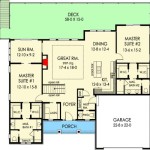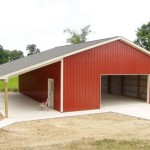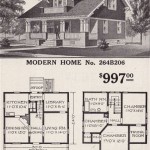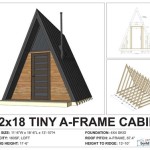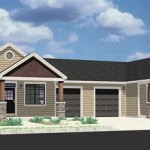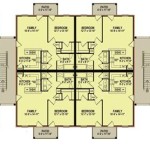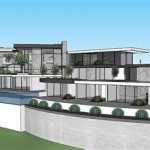Single Story House Plans with Porch: A Comprehensive Guide
Single story house plans with a porch represent a popular choice for prospective homeowners, offering a blend of accessibility, comfort, and aesthetic appeal. The inclusion of a porch extends the living space outwards, creating an area for relaxation, social interaction, and enhancement of curb appeal. This article aims to provide a comprehensive overview of single story house plans with porches, encompassing various design considerations, advantages, and relevant factors to consider during the planning and construction phases.
The design of single story house plans with porches is highly adaptable, catering to a diverse range of preferences and lifestyle requirements. From simple, understated designs to more elaborate and architecturally distinguished structures, the possibilities are extensive. The integration of the porch into the overall design requires careful consideration of factors such as site orientation, climate, and desired functionality.
Advantages of Single Story House Plans
Single story house plans offer several distinct advantages, particularly for individuals and families seeking ease of access and a simplified living experience. These benefits contribute to the enduring popularity of this architectural style.
First, the absence of stairs makes single story homes exceptionally accessible for individuals with mobility limitations, including the elderly and those with physical disabilities. This aspect is often a crucial consideration for aging in place, ensuring that the home remains suitable and comfortable throughout the homeowner's life. The elimination of stairs also reduces the risk of falls, a significant safety concern for young children and older adults.
Second, single story layouts typically promote a more open and connected living environment. With all living spaces on a single level, there is often a greater sense of flow and accessibility between rooms. This can enhance communication and interaction among family members, fostering a more cohesive and sociable atmosphere. Furthermore, the ease of moving furniture and belongings within a single story home simplifies the moving process and reduces the physical strain associated with navigating stairs.
Third, single story homes can be more energy-efficient than multi-story structures. Heat naturally rises, leading to temperature imbalances in multi-story homes, often resulting in higher heating and cooling costs. In single story homes, the consistent temperature distribution can contribute to lower energy consumption and reduced utility bills. Furthermore, the simpler roofline of many single story designs can make them easier and more cost-effective to insulate, further enhancing energy efficiency.
Porch Design Considerations
The design of the porch is a critical element in any single story house plan. The porch serves not only as an aesthetic feature but also as a functional extension of the living space. Various factors must be carefully considered to ensure that the porch complements the overall design of the house and meets the specific needs of the homeowners.
First, the size and configuration of the porch should be proportionate to the size of the house and the available lot space. A porch that is too large can overwhelm the house and detract from its curb appeal. Conversely, a porch that is too small may not provide adequate space for relaxation or entertaining. The optimal size and shape of the porch will depend on individual preferences and the intended use of the space.
Second, the orientation of the porch is crucial for maximizing its usability and comfort. Ideally, the porch should be oriented to take advantage of natural light and prevailing breezes, while also providing shade from the harsh afternoon sun. The orientation should also consider the views from the porch, ensuring that the homeowners can enjoy pleasant scenery and a sense of privacy. In regions with particularly harsh weather conditions, such as heavy rain or strong winds, the porch design should incorporate features such as overhangs or windbreaks to provide protection and comfort.
Third, the materials used for the porch construction should be durable, weather-resistant, and aesthetically consistent with the overall design of the house. Common materials for porch construction include wood, composite decking, concrete, and stone. The choice of materials will depend on factors such as budget, maintenance requirements, and desired aesthetic appeal. It is also important to consider the structural integrity of the porch, ensuring that it is built to withstand the weight of furniture, people, and potential snow loads.
Styles and Types of Porches
The design of a porch can significantly influence the overall aesthetic of a single story home. Numerous styles and types of porches exist, each offering a distinct look and feel. Selecting the right style can enhance the architectural character of the house and create a welcoming and inviting entrance.
A front porch, typically located at the front of the house, is designed primarily for greeting guests and providing a transition between the exterior and interior spaces. These porches are often designed with ample seating and decorative elements to create a welcoming ambiance. A front porch can significantly enhance curb appeal and contribute to a sense of community engagement.
A screened-in porch offers protection from insects and other outdoor elements, allowing homeowners to enjoy the outdoors in comfort. These porches are typically enclosed with screens, providing ventilation while keeping pests out. Screened-in porches are ideal for dining, relaxing, and entertaining, particularly in regions with warm climates and prevalent insect populations.
A wraparound porch extends around multiple sides of the house, providing ample outdoor living space and enhancing the architectural appeal of the home. Wraparound porches are often associated with traditional architectural styles, such as Victorian and farmhouse designs. These porches offer versatile spaces for relaxation, entertaining, and enjoying the surrounding landscape.
A covered porch provides protection from the elements, allowing homeowners to enjoy the outdoors even during inclement weather. These porches are typically covered by a roof, providing shade from the sun and shelter from rain and snow. Covered porches are ideal for outdoor dining, reading, and relaxing in a variety of weather conditions.
A sunroom, while technically not simply a porch, can function similarly and may sometimes be designed to incorporate features of a porch. A sunroom is enclosed with glass, providing natural light and warmth while protecting from the elements. Sunrooms are ideal for growing plants, relaxing, and enjoying panoramic views of the surrounding landscape.
A portico is a covered entrance, often supported by columns, providing shelter for visitors arriving at the front door. Porticos are typically smaller than traditional porches and are designed primarily for functional purposes, such as providing protection from the weather. However, a well-designed portico can also enhance the architectural appeal of the home.
The selection of the appropriate porch style will depend on factors such as personal preferences, architectural style of the house, climate, and intended use of the space. Careful consideration of these factors will ensure that the porch complements the overall design of the house and provides a functional and aesthetically pleasing outdoor living space.
Beyond the structural components, attention to detail is paramount in creating a welcoming and functional porch. Landscape design plays a crucial role in enhancing the porch's appeal. Incorporating plants, flowers, and shrubs can soften the lines of the structure and create a more inviting atmosphere. Comfortable seating arrangements, such as rocking chairs, benches, or outdoor sofas, encourage relaxation and social interaction. Lighting fixtures, such as sconces, pendant lights, or string lights, can create a warm and inviting ambiance during the evening hours. Furthermore, decorative elements, such as outdoor rugs, throw pillows, and artwork, can add personality and style to the porch.
When planning a single story house with a porch, it is essential to consult with experienced architects and contractors. These professionals can provide valuable guidance on design considerations, building codes, and material selection. Seeking professional advice can help ensure that the project is completed safely, efficiently, and to the homeowner's satisfaction. Professional input can also help to avoid costly mistakes and ensure that the porch is structurally sound and aesthetically pleasing.

Cottage House Plan With 3 Bedrooms And 2 5 Baths 6619

One Story Country Craftsman House Plan With Screened Porch Architectural Designs 24392tw Plans

One Story House Plans With Porches Dfd Blog

One Story Cottage Style House Plan

Stylish One Story House Plans Blog Eplans Com

One Story House Plans With Porches Dfd Blog

Plan 8462jh Marvelous Wrap Around Porch In 2024 House Plans One Story With Farmhouse

Shepherds Crossing House Floor Plan Frank Betz Associates

One Story House Plans Single Floor Design

4 Bedroom Single Story Modern Farmhouse With Wraparound Porch And Vaulted Primary Suite Floor Plan Plans House


